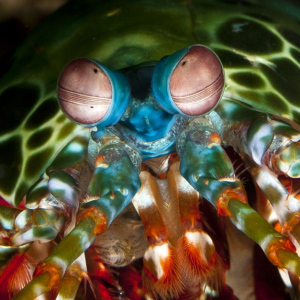
Meet Larisa and Sipura, the newborn panther twins that were introduced to the world in Berlin yesterday.
Still smaller than a domestic housecat, their black fur is sleek and their bright blue-green eyes stare unflinchingly at the cameras.

Newborn baby panthers Larisa and Sipura stare at photographers during a media presentation of the cubs at the Tierpark zoo

Showtime: The eyes of one of the panther cubs appears to match the green of the grass around her as she stares unflinchingly at the camera
The pair, both female, were born on April 26 at the Tierpark Zoo in Berlin.
Black panther cubs are born with their eyes closed, not opening them until about ten days after the birth.
They do not gain enough mobility to move around until two or three weeks after the birth – and do not start to eat meat until they are nearly three months old.
Their permanent canine teeth do not come in until the age of one – and by the age of two panthers in the wild are usually independent of their mothers.

Larisa and Sipura cling to the top of a wicker basket at the zoo in Berlin. The pair, twin females, were born April 26

Even hardened news photographers have to crack a smile as one of the cubs stumbles through the grass
In the wild black panthers usually live for up to twelve years – but, born in captivity, Larisa and Sipura may grow to be 20 years old.
The term ‘black panther’ can be confusing, with scientists agreeing it does not refer to a specific sub-species of big cat.
Most generally, the term refers to any type of big cat with a black coat – though the only scientifically recognised definitions are a black leopard and a black jaguar.

In the sunlight, darker black spots can be seen beneath the cubs’ dark fur

The cubs take a brief refuge inside the wicker basket





